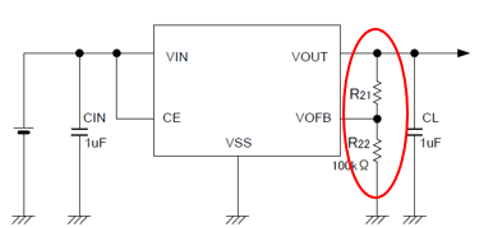Output voltage setting method
There are two major types of setting methods for voltage regulator output voltage.
The first is the “output voltage fixed type” for which the output voltage is set inside the IC. Most voltage regulators are of this type.
The main merits of this type are that only the part number for the desired output voltage needs to be selected and the design is simple, external components are unnecessary, and the output voltage accuracy is high.
The second is the “output voltage external adjustment type”. Generally, two externally attached resistors are used to adjust the output voltage.
This type has such merits as easy output voltage adjustment and component aggregation since multiple output voltages can be created using one product or part number.


Output voltage range
The output voltage range is the output voltage range in which the voltage regulator can output the desired characteristics.
With the “output voltage fixed type”, the output voltages that can be selected are fixed, so the output voltage is selected from among these.
With the “output voltage externally adjustment type”, the output voltage is set within the prescribed range that is within the output voltage range. Setting the output voltage outside the output voltage range could prevent the desired characteristics and functions from being obtained or could cause a malfunction.
Output voltage accuracy
This is the voltage accuracy of the output voltage.
Generally, it specifies the output voltage accuracy for a specific input voltage and output current.
With the “output voltage externally adjustment type”, externally attached components are required to adjust the output voltage. For this reason, the overall output voltage accuracy for the voltage regulator is decreased by the resistance variance of the externally attached components.
With the “output voltage fixed type”, the feedback resistance is contained within the IC, so there is no decrease in accuracy due to an externally attached resistance.